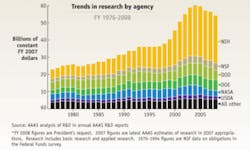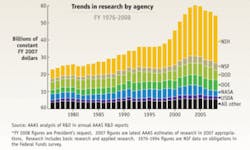When I began cutting my teeth on optics and photonics in the early 1990s as a staff writer and later managing editor for Optics & Photonics News, Bill Clinton had just swept into office with an agenda to beef up U.S. technology-related activities. He had a strong idea of what he wanted federal science to produce—not just science for science’s sake but science with a strong link to applications. Programs such as the Technology Reinvestment Project and expansion of the existing Advanced Technology Program (ATP) were aimed at improving America’s ability to compete with the rest of the world. Funding became increasingly dependent on how basic science translated into real-world applications.
Clinton’s technology agenda was a catalyst in many ways for the bio-optics field. The push to translate military research into civilian applications meant leveraging photonics technology. The drive to develop the Internet expanded telecommunications technologies. For early adopters, connecting the dots between photonics, biology, and medicine meant the beginning of the current bio-optics wave.
Bio-optics as a category has only been a budget line in a few federal agencies for about seven years. That’s not a long time compared to disease-related funding such as cancer. The first mention of the need to support bio-optics came in 1998 when the National Research Council published “Optical Science and Engineering for the 21st Century.” In their Summary and Recommendations, the authors wrote: “NSF should increase its efforts in biomedical optics and pursue opportunities in this area aggressively.”
The largest federal agency devoted to advancing bioimaging, the National Institute of Biomedical Imaging Bioengineering (NIBIB), just celebrated its fifth anniversary. I’ve been working with NIBIB for the last five years on editorial projects and writing for their Web site. From this vantage point, I’ve seen first-hand how federal investment in bio-optics is starting to pay off. The presence of NIBIB gives an important voice to the bio-optics community. Bio-optics is one of the few technologies that can bridge both basic research and clinical application. Optical-imaging advocacy groups now have a strong portfolio of technologies they can discuss when educating lawmakers on the benefits of the field. While technical hurdles remain, it’s safe to say that bio-optics will be one of the key drivers in transforming the current medical paradigm into what NIH Director Elias Zerhouni describes as one that is predictive, preemptive, personalized, and participatory.
NIH leads the way
Consider the impact of Congress’ decision to double the NIH budget from 1999 to 2003 (see figure). The budget is now about $30 billion, or half of the U.S. research budget. Such generous funding, according to John Marburger, director of the White House’s Office of Science and Technology Policy, has had “a profound impact on the nation’s biomedical research enterprise.”
In a speech given at the American Association for the Advancement of Science (AAAS) Policy Forum in May 2007, Marburger described the biomedical research enterprise as “a miniature economy with its own labor pool, markets, productive capacity, and business cycles. The response to the NIH doubling has been an abrupt increase in research capacity, financed not only by the direct federal investment but by state governments and private-sector sponsors eager to leverage this investment, not least to enhance competitiveness for additional federal funds.”
Marburger went on to describe how the “enlarged biomedical R&D labor pool is populating new, expanded research facilities and writing federal grant proposals in competition with the previous still-productive generation of their faculty advisors.” And the young researchers are starting to train yet another group of new researchers who hope to follow the same pattern.
He warned, however, that such an expansion cannot be sustained by the same business model that led to its creation. “New capacity can only be sustained by new revenue sources,” he says. Those sources will come from new partnerships with private backers. In fact, since 2003 NIH budgets have been flat, creating a tight funding picture.
“I think funding for investigators working on life science/photonics is likely to be stable but not dramatically increasing,” Marburger says. “One thing that’s affecting the perception of how well off investigators are is continually increasing competition for funds. The competition in many areas will grow faster than the funds, even under fairly generous budgets.”
The right fit
To increase chances of success in this highly competitive environment, those seeking support must carefully match their proposal with the right funding agency. Leon Esterowtiz, program director for Biophotonics, Advanced Imaging, and Sensing for Human Health (BISH) at the National Science Foundation (NSF), tells of one researcher with a successful track record of receiving grants who was funded by NSF, went to NIH for funding, was turned down, and came back to NSF to obtain additional money.
“The project was too technology oriented,” he says.
NSF, which has funded bio-optics for the last seven years, is willing to back proposals with a long horizon, according to Esterowitz. “We support far-out ideas that don’t need a near-term payoff. We’re willing to wait a decade and take a higher risk,” he says.
One such project, an optical approach to detecting early-stage pancreatic cancer, got its start at NSF and is now close to clinical trials with funding from NIBIB. Not an unusual occurrence, according to Esterowitz.
“If you don’t take a risk with some of these technologies, you won’t be able to do these wonderful things,” he says. “You could miss the boat.”
Esterowitz, a former Naval Research Laboratory (NRL) scientist, saw a huge potential in biology and medicine for photonics technologies developed for military applications. While at NRL he gave a couple of presentations to NSF and began working there in October 1999. The first BISH solicitation in 2000 was intended to exploit the power of photonics.
“We wanted to take advantage of the wonderful technologies developed for other reasons that could be used in medicine,” he says. The program, whose budget is about $5 million, was renamed in 2007 to indicate its expansion beyond medicine into technologies for energy and the environment. “There’s a role for biophotonics to play in all of that,” he says.
High risk, high payoff
The trend at many federal science agencies is to fund high-risk, high-payoff proposals from multidisciplinary teams, while continuing to support projects that offer incremental progress in a field. Part of this trend results from recommendations from a National Academy of Sciences 2005 report, “Rising Above the Gathering Storm,” which examined areas where the U.S. was in danger of losing its competitive edge. The report authors recommended “allocating at least 8% of the budgets of federal research agencies to discretionary funding that would be managed by technical program managers in the agencies and be focused on catalyzing high-risk, high-payoff research of the type that often suffers in today’s increasingly risk-averse environment.”
Another reason for the push toward high-risk research is better-educated consumers.
“Patients play a big role,” says Renee Cruea, president of the Coalition for Imaging and Bioengineering Research. “Patients are far more proactive and ready to call their senators and congressmen and voice concerns. They want to see the research done. They want tools to live better or longer.”
In response to criticism that NIH was not supporting high-risk, high-payoff research, Director Elias Zerhouni began the NIH Director’s Pioneer Awards program, which provides up to $500,000 per year for five years for projects that promise to transform medical research. A companion program announced in March 2007 is the NIH director’s New Innovator Award. The award, which offers up to $1.5 million in direct costs over five years, is open to new investigators who have not received an NIH regular research (R01) or similar grant.
NIBIB has its own version of these grants, the Quantum Awards. In October 2007 NIBIB announced grants totaling $12 million for high-risk, high-impact research aimed at solving major medical problems. Recently funded Quantum Awards include nanoparticle-enabled intraoperative imaging and photoactivated therapy to improve surgical resection and treatment options for brain-cancer patients. The Quantum Awards offer an opportunity to fund proposals that could have a profound impact on healthcare but may not get funded in the normal project review process because the goals are long-range, very risky, and lack strong preliminary data.
“Risk and impact go hand in hand,” says NIBIB Director Roderic Pettigrew. “Targeting grand challenges will often entail assuming big risks.”
Pettigrew describes bio-optics technologies as critical to improving fundamental knowledge of how the human body functions at a subcellular level. While one of the new frontiers of investment is for technologies that enable the observation of intra- and intercellular behavior, he also sees bio-optics playing a crucial role in diagnostics.
“Five years ago point-of-care technologies were not really discussed; now they’re front and center, and biophotonics will definitely play a key role,” he says.
It is clear that bio-optics is here to stay as far as federal funding agencies are concerned. But as competition for federal dollars continues, industry partnerships and private financing will be needed. To convert bio-optics technologies from benchtop to bedside, inventors will have to make a strong case to industry. While device companies are interested in optical technologies, diagnostic tests in general don’t produce the same kind of revenue stream that therapeutics produce, according to former National Cancer Institute Cancer Imaging Program Director Daniel Sullivan.
“They [device companies] see a market and are interested, but the amount of money invested is not the same,” he says. Sullivan, who now leads the Imaging Program at Duke University’s Comprehensive Cancer Center, was able to triple the CIP budget from $49 million in 1997 to $180 million in 2007. But as CIBR’s Cruea notes, real scientific payoffs occur when industry backs up research.
“It’s very important not to legislate science,” she says. “It has to be a natural progression.”
About the Author


